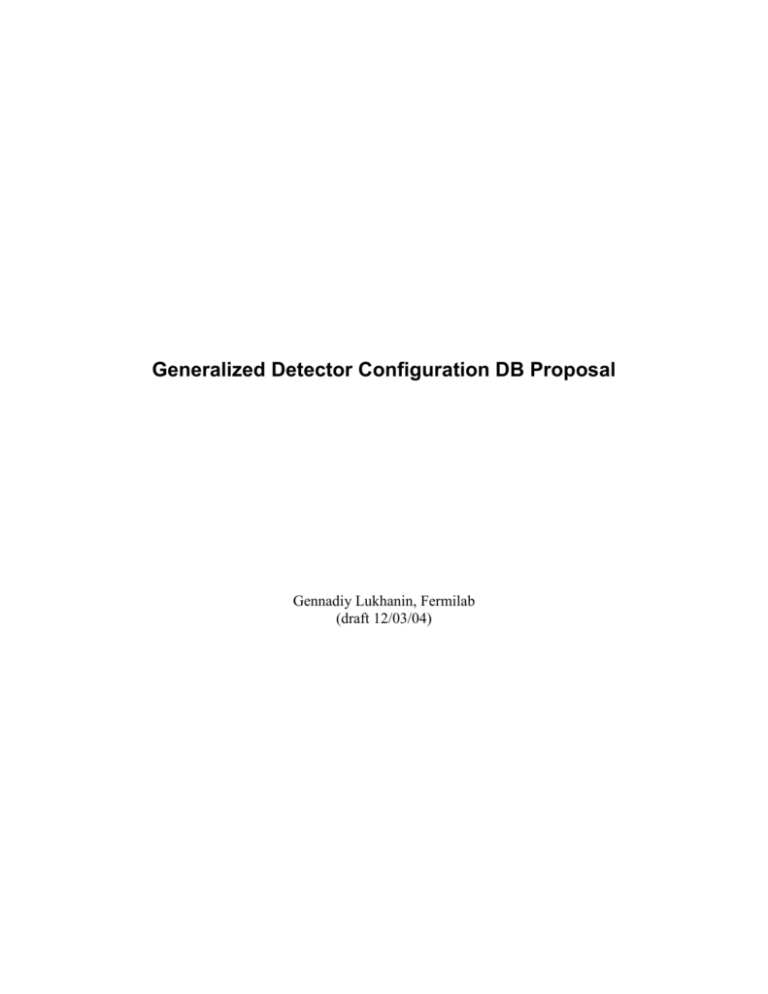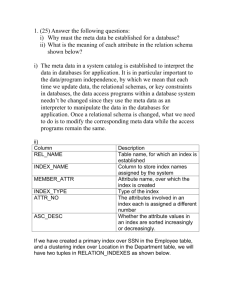oracle3
advertisement

Generalized Detector Configuration DB Proposal Gennadiy Lukhanin, Fermilab (draft 12/03/04) Table of contents Table of contents .............................................................................. 2 1 Introduction ................................................................................ 3 2 Design objectives ....................................................................... 3 3 Overview of existing databases ................................................. 3 4 Design blocks ............................................................................. 4 4.1 4.2 4.3 4.4 4.5 5 Hierarchal structure ............................................................................................. 4 Signal connections .............................................................................................. 8 Predefined attributes ......................................................................................... 11 History records .................................................................................................. 14 Final design ....................................................................................................... 14 Conclusion ............................................................................... 15 2 1 Introduction Modern experiments require complicated equipment, consisting of millions of parts, so it becomes important to have an accurate tracking capability during construction and operation phases. CMS collaboration had chosen to address this problem with a database driven solution. There are four database types proposed by the collaboration for each sub-detector system: construction, equipment, conditions-online & conditionsoffline. This document is to present a design overview of proposed database schema and architecture for construction and equipment management databases for HCAL that can be expended to other sub-detectors. This schema can be extended and reference on/off-line conditions databases. 2 Design objectives The major design objectives are: reuse of existing schema components, generic approach without going deep into component specifics, ensure database integrity by using constraints, scalability & rapid prototype delivery. Several existing database schemas at CERN and Fermilab were analyzed and their design patterns will be reused. This approach will reduce data migration / conversion effort. 3 Overview of existing databases “Rack Wizard” (Frank Glege) is an inventory management system with a user web interface. It is used by several LHC projects including CMS. Its schema design represents hierarchical detector structure and contains GEANT geometry and material composition of detector parts. It also keeps track of all measurement equipment sitting in racks. “HCAL equipment configuration db” (Yuyi Guo) is an equipment database. It provides information about individual elements, detector map and connection information. “RBX-QC” database (Sergey Sergueev) is quality control system for RBXs with Borland C++ user interface and Paradox database (considering Oracle migration). It has some elements of construction database. 3 4 Design blocks 4.1 Hierarchal structure The design pattern, representing a hierarchal structure, is a first schema block. It was taken from “Rack Wizard” (fig. 0). PHYSICAL PART entity is a super-type (a parent) for any physical part (or component) that needs to be tracked in the system. This entity has bare minimum information used to identify the part and does not provide any details on it. Parts of any kind (or type) must be extended from the PHYSICAL PART entity. CRATE, BOARD, CABLE, HCAL WEDGE and HCAL TOWER entities must have a primary key which is a foreign key (at the same time) to the PHYSICAL PART entity. This constraint will ensure exactly one record for any part entered in the system. All part attributes should be stored in extended entities: CRATE, BOARD and etc. PHYSICAL PART should be populated by the extended entity trigger, only. MATERIAL # NAME * DENSITY parent side PHYSICAL PART TREE to from SOLID DETECTOR PART child side o SOLID_ID o MATERIAL_ID o PART_ID from from # NAME * SOL_TYPE to to describes PHYSICAL PART # PART_ID o BARCODE o SERIAL_NUMBER refers to to extends extends to to extends to to extends BOARD HCAL WEDGE CABLE HCAL TOWER o ATTR1 o ATTR2 o ATTR1 o ATTR2 * * o o o o ATTR1 o ATTR2 VERSION BARCODE LABLE LENGTH COMMENTS extends CRATE o ATTR1 o ATTR2 Fig. 0 4 Sample data: PHYSICAL PART PART_ID 1 2 3 4 5 6 7 BARCODE AA1234 AA1235 BB123EE AA1237 AA1238 BB123E1 AA1240 SERIAL_NUMBER SWAR1234 SWAR1235 SWAR1236 SWAR1237 SWAR1238 SWAR1239 SWAR1240 CABLE PART_ID Length 1 7 Diameter 12 123 5 5.6 BOARD PART_ID Size Power 2 4 5 12 45 123 InstalledBy 45.2 6.2 8.4 Mick John Mick CRATE Size PART_ID 3 6 InstalledBy 45.2 6.2 Mick John The relationship between parts (or containment) is defined by PHYSICAL PART TREE entity. It identifies the parent for a given child part. This relationship is shown as a circle (fig. 1). This design pattern allows any kind of relationships, even invalid ones. Let’s say CRATE can be contained in a CABLE. This issue can be solved by adding database constraints. 5 AERAL #E * Y te i o PHYS CALARTREE m SD DEECRPART o D o D o D h de m #E * E o m s o PHYS CALART #D o E o R so Fig. 1 There are two types of constraints: design time constraints and run-time constraints. Design time constraints or foreign keys & check constraints are created during the database schema design and deployed as a part of it. Foreign keys are represented by lines on the entity-relationship diagrams. Run-time constraints or logical data driven constraints can be added or removed at the run time and do not require the schema change. This design is relying on the second type of constraints. They enable only valid relationship types (fig. 2). The PART TO PART RELATIONSHIP entity defines a valid parent-child relationship between two KIND OF PART entities. A PHYSICAL PART TREE entity (or parent–child relationship) can not be created without specifying a corresponding PART TO PART RELATIONSHIP entity. 6 MATERIAL # NAME * DENSITY child side to PHYSICAL PART TREE DETECTOR PART from o SOLID_ID o MATERIAL_ID o PART_ID parent side SOLID from # NAME * SOL_TYPE to from describes has to PHYSICAL PART # PART_ID o BARCODE o SERIAL_NUMBER refers to belons PART TO PART RELATIONSHIP is kind of # PART_TO_PART_RELATIONSHIP_ID o PRIORITY o DISPLAY_NAME child specifies rel child ref parent rel parent ref KIND OF PART # KIND_OF_PART_ID * IS_DETECTOR_PART * EXTENSION_TABLE_NAME Fig. 2 Sample data: PHYSICAL PART PART_ID 1 2 3 4 5 6 7 BARCODE AA1234 AA1235 BB123EE AA1237 AA1238 BB123E1 AA1240 SERIAL_NUMBER SWAR1234 SWAR1235 SWAR1236 SWAR1237 SWAR1238 SWAR1239 SWAR1240 KIND_OF_PART 45 128 128 253 128 253 45 KIND OF PART KIND_OF_PART_ID 128 45 253 EXTENSION_TABLE_NAME BOARD CABLE CRATE 7 BOARD PART_ID Size Power 2 4 5 InstalledBy 45.2 6.2 8.4 12 45 123 Mick John Mick CRATE Size PART_ID 3 6 InstalledBy 45.2 6.2 Mick John PART TO PART RELATIONSHIP PART_TO_PART_RELATIONSHIP_ID 345 1 PARENT_KIND_ID 128 253 CHILD_KIND_ID 128 128 PRIORITY 1 2 PHYSICAL PART TREE PART_ID 2 5 PARENT_PART_ID 4 3 PART_TO_PART_RELATIONSHIP_ID 345 1 Comment: the last record in PHYSICAL PART TREE says: a board with a barcode AA1238 is installed in the crate with a serial number BB123EE. The detector part assembly sequence can be critical in certain cases. The design introduces a relationship priority model used to define the order in which parts are put together. Relationships with lover priority numbers should be established first. In our example we need to attach two boards together before installing them in crate. 4.2 Signal connections Another aspect of the detector assembly is signal wiring. It comes with a second schema block (fig. 3). It was taken from HCAL equipment database. Signal wiring is another form of part to part relationship involving three components: connection start and end parts and the third one connecting them together. The SIGNAL CONNECTION TYPE entity is an equivalent of PART TO PART RELEATIONSHIP. Detector components like circuit boards, modules and others may have multiple connectors attached to them. This information is stored in CONNECTOR entities. The diagram reads:” any physical part can have any number of connectors attached to it”. The 8 SIGNAL CONNECTION entity identifies connected parts. Two physical parts can be connected only if the signal connection type is defined for their kinds (or types). MATERIAL # NAME * DENSITY parent side to PHYSICAL PART TREE from SOLID DETECTOR PART o SOLID_ID o MATERIAL_ID o PART_ID child side from # NAME * SOL_TYPE to from describes to PHYSICAL PART # PART_ID o BARCODE o SERIAL_NUMBER SIGNAL CONNECTION TYPE refers to # SIGNAL_CONNECTION_TYPE_ID o COMMENTS defines conn end part ref has conn start part ref is kind of conn start point conn end point cable ref signal end part signal start part cable part attached to CONNECTOR # * * o CONNECTOR_ID SIGNAL_DIRECTION CONNECTOR_LABEL COMMENTS SIGNAL CONNECTION # CONNNECTION_ID o COMMENTS defined by specifies end con ref end conn start ref conn end ref KIND OF PART # KIND_OF_PART_ID * IS_DETECTOR_PART * EXTENSION_TABLE_NAME start con ref start Fig. 3 Sample data: PHYSICAL PART PART_ID 1 2 3 4 5 6 7 BARCODE AA1234 AA1235 BB123EE AA1237 AA1238 BB123E1 AA1240 SERIAL_NUMBER SWAR1234 SWAR1235 SWAR1236 SWAR1237 SWAR1238 SWAR1239 SWAR1240 KIND_OF_PART 45 128 128 253 128 253 45 KIND OF PART KIND_OF_PART_ID 128 45 253 EXTENSION_TABLE_NAME BOARD CABLE CRATE 9 BOARD PART_ID Size Power 2 4 5 InstalledBy 45.2 6.2 8.4 12 45 123 Mick John Mick CONNECTOR CONNECTOR_ID 342 1244 1234 PART_ID 2 2 5 SIGNAL_DIRECTION in in out LABEL J45-1 DD32-1 J45-2 CABLE PART_ID Length 1 7 Diameter 12 123 5 5.6 SIGNAL CONNECTION TYPE SIGNAL_CONNECTION_TYPE_ID 56 START_PART_KIND_ID 128 END_PART_KIND_ID 128 SIGNAL CONNECTION SIGNAL_CON NECTION_ID 856 SIGNAL_CONNEC TION_TYPE_ID 56 START_ PART_ID 2 END_PA RT_ID 5 CABLE_ID 7 START_C NCTR_ID 342 END_CN CTR_ID 1234 Comment: the record in SIGNAL CONNECTION table says: two boards with barcodes AA1235 and AA1238 are connected by the cable AA1240 which is attached to connectors J45-1 and J45-2 respectfully. 10 4.3 Predefined attributes There is a special group of attributes that defines some soft of conventions, e.g. position and numbering schemas, types, categories, grades, phases, stages and etc. These attributes have fixed values and can be pre-loaded into the database and assigned later to detector parts (fig. 4). A set of attributes forms an attribute catalog, e.g. a sequence of numbers 1…16, defining a blade position on a disk, forms a blade-disk position catalog. Each attribute must have a VALUE, used as a primary identification, and any set of supplemental description attributes (addition columns in some attribute table) refining the meaning of it. Attribute catalogs with identical description attribute structures (or same set of columns) are combined into an attribute entity with one common name. For example: all positioning and numbering catalogs can be represented by POSITION NUMBERING SCHEMA entity; all kinds of part types become PART TYPE entity. This approach significantly reduces the number of entity types (or tables) required to store them. All attributes are extended from the ATTRBASE entity (attribute super-type or base class). ATTRBASE is populated by a trigger of the extended attribute entity. The idea is similar to one described in the first paragraph of section 4.1. The PART TO ATTRIBUTE RELATIONSHIP entity defines what attribute catalog is used to describe a given KIND OF PART. A PHYSICAL PART has a list of attributes (ATTRIBUTE LIST entity) assigned to it. MATERIAL # NAME * DENSITY parent side to PHYSICAL PART TREE from SOLID DETECTOR PART o SOLID_ID o MATERIAL_ID o PART_ID child side from # NAME * SOL_TYPE to from describes to PHYSICAL PART # PART_ID o BARCODE o SERIAL_NUMBER refers to is kind of has attributes specifies KIND OF PART # KIND_OF_PART_ID * IS_DETECTOR_PART * EXTENSION_TABLE_NAME referes to belogs to part ATTRIBUTE LIST # ATTRIBUTE_LIST_ID POSITION NUMBERING SCHEMAS o VALUE extends combined of defined by belongs to ATTRBASE base # ATTRIBUTE_ID base belongs to catalog extends PART TYPES o VALUE referes to has ATTR CATALOG # * o o ATTR_CATALOG_ID VISUAL_STYLE DESCRIPTION EXTENSION_TABLE_NAME defined by PART TO ATTR RELATIONSHIP refers to # PART_TO_ATTR_RELATIONSHIP_ID o DISPLAY_NAME defined by Fig. 4 11 Sample data: PHYSICAL PART PART_ID BARCODE AA1234 AA1235 BB123EE AA1237 AA1238 BB123E1 AA1240 1 2 3 4 5 6 7 SERIAL_NUMBER SWAR1234 SWAR1235 SWAR1236 SWAR1237 SWAR1238 SWAR1239 SWAR1240 KIND_OF_PART 45 128 128 253 128 253 45 KIND OF PART KIND_OF_PART_ID 128 45 253 EXTENSION_TABLE_NAME BOARD CABLE CRATE BOARD PART_ID Size Power 2 4 5 InstalledBy 45.2 6.2 8.4 12 45 123 Mick John Mick ATTR CATALOG ATTR_CATALOG_ID 456 675 VISUALSTYLE Radio button on a page Drop down box on a page EXTENSION_TABLE_NAME PART_GRADES POSITION_NUMBERING_SCHEMAS Description Power consumption grade Position of a board in a crate PART TO ATTR RELATIONSHIP PART_TO_ATTR_RELATIONSHIP_ID 2345 1632 ATTR_CATALOG_ID 456 675 KIND_OF_PART_ID 128 128 ATTRBASE ATTRIBUTE_ID 54 55 125 126 78 ATTR_CATALOG_ID 675 675 456 456 675 12 POSITION NUMBERING SCHEMAS ATTRIBUTE_ID VALUE 54 55 78 SLOT 1 SLOT 2 SLOT 3 PART GRADES ATTRIBUTE_ID RANGE VALUE 125 126 <10W >10W PWR-A PWR-B ATTRIBUTE LIST ATTRIBUTE_LIST_ID 457 856 PART_ID ATTRIBUTE_ID 4 4 55 126 PART_TO_ATTR_PELATIONSHIP_ID 675 456 Comment: records in ATTRIBUTE LIST table saying: a boards with barcode AA1237 has two predefined attributes SLOT 2 & PWR-B. 13 4.4 History records History records will be created as the detector system evolves. Each extended part entity, e.g. CABLE, CRATE, BOARD (see section 4.1), has a corresponding child history entity (or child table) attached to it. A history entity has all attributes of a parent including predefined attributes, described in the previous section. History entities are implied and not shown on the schema diagram. 4.5 Final design Fig. 5 has all design blocks put together. SOLID # NAME * SOL_TYPE to from MATERIAL # NAME * DENSITY to DETECTOR PART o SOLID_ID o MATERIAL_ID o PART_ID parent side from PHYSICAL PART TREE describes from HCAL WEDGE o ATTR1 o ATTR2 refers to PHYSICAL PART has # PART_ID o BARCODE o SERIAL_NUMBER HCAL TOWER o ATTR1 o ATTR2 child side to extends to extends to BOARD o ATTR1 o ATTR2 extends belons to CRATE o ATTR1 o ATTR2 PART TO PART RELATIONSHIP to extends to CABLE * * o o o VERSION BARCODE LABLE LENGTH COMMENTS SIGNAL CONNECTION TYPE # SIGNAL_CONNECTION_TYPE_ID o COMMENTS # PART_TO_PART_RELATIONSHIP_ID o PRIORITY o DISPLAY_NAME is kind of cable ref has extends conn start part ref conn end part ref parent child defines conn start point has attributes conn end point cable part signal start part signal end part attached to conn start ref rel child ref rel parent ref CONNECTOR # CONNECTOR_ID * SIGNAL_DIRECTION * CONNECTOR_LABEL o COMMENTS conn end ref SIGNAL CONNECTION start con ref start # CONNNECTION_ID o COMMENTS specifies defined by end con ref KIND OF PART # KIND_OF_PART_ID * IS_DETECTOR_PART * EXTENSION_TABLE_NAME end referes to belogs to part ATTRIBUTE LIST # ATTRIBUTE_LIST_ID combined of PART TYPES defined by extends o VALUE defined by belongs to referes to ATTRBASE base base PART TO ATTR RELATIONSHIP # ATTRIBUTE_ID # PART_TO_ATTR_RELATIONSHIP_ID o DISPLAY_NAME belongs to catalog defined refers to by extends ATTR CATALOG POSITION NUMBERING SCHEMAS o VALUE has # ATTR_CATALOG_ID * VISUAL_STYLE o DESCRIPTION o EXTENSION_TABLE_NAME Fig. 5 14 5 Conclusion The described model comes as a logical integration of existing databases into one compact system design (only 11 core tables), specifically targeted to minimize migration efforts associated with it. The design was kept at the high level and broken into distinct functional blocks. These blocks can be used to define project implementation delivery phases. The addition of run-time constraints offers improved data integrity and flexibility to add new components at a later time. 15







